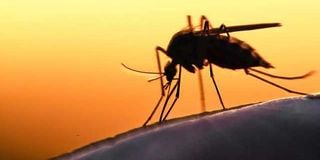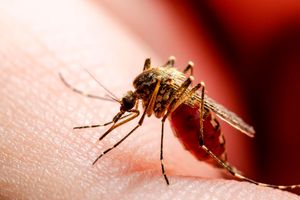Concern as new, lethal species of mosquito reported in Kenya

The new mosquito species, scientifically identified as Anopheles stephensi, has been reported in many African countries including Nigeria, Ethiopia, Somalia, Sudan and Djibouti.
What you need to know:
- The mosquito, scientifically identified as Anopheles stephensi, has been reported in many African countries including Nigeria, Ethiopia, Somalia, Sudan and Djibouti and it prefers urban areas.
- It is responsible for sustaining malaria transmission in Ethiopia with the potential to increase malaria incidence by 50 per cent.
- The WHO said in a statement that if nothing is done, the species will put more than 126 million people in 44 cities at risk of malaria.
A new, deadlier mosquito species—which breeds in highly populated, urban areas, breeds all year round, and has the potential to increase malaria incidences by more than 50 per cent—has been reported in Kenya.
In a paper published in the Research Square Journal two weeks ago, the mosquito was reported in two sub-counties (Laisamis and Saku) of Marsabit County, with a focus on urban and rural settings along the northern transport corridor connecting Kenya and Ethiopia.
With the findings, malaria transmission in northern Kenya is likely to increase, causing a significant threat to the control and elimination of the disease in the country.
This, the paper says, will spread to highly populated urban areas and existing malaria-endemic counties, further compounding the problem of malaria control in Kenya.
The mosquito, scientifically identified as Anopheles stephensi, has been reported in many African countries including Nigeria, Ethiopia, Somalia, Sudan and Djibouti and it prefers urban areas.
It is responsible for sustaining malaria transmission in Ethiopia with the potential to increase malaria incidence by 50 per cent, according to recent mathematical modelling of the potential impact of Anopheles stephensi that has since been observed in Djibouti.
The mosquito is known to transmit both Plasmodium falciparum and as Plasmodium vivax.
Ability to develop
This vector differs from other malaria vectors due to its ability to develop in man-made containers, preferably in clean water, but also in contaminated water.
These traits have enabled An. stephensi to colonise urban settings where it can sustain transmission of malaria.
Additionally, it is an efficient vector in rural areas.
People in urban areas tend to have minimal exposure to malaria, making them more susceptible to the disease.
Unlike other mosquitoes in Africa caused by Anopheles gambiae species with populations rising and falling with the rainy seasons, Anopheles stephensi transmit malaria throughout the year.
The study indicated that the species is a threat to malaria control and elimination, particularly in Africa, where the disease hits hardest.
According to the World Health Organization (WHO), the species is said to be resistant to several classes of insecticides traditionally used to treat bed nets and home environments, has the propensity to bite both indoors and outdoors and feeds on both animal and human blood.
Poor garbage disposal, coupled with disruption in pipe-borne water supply, facilitates the breeding of the mosquito.
Its larvae thrive in man-made water tanks, poorly discarded plastic containers, wells and fresh pools of water.
According to Dr Eric Ochomo, a medical entomology and senior research officer at the Kenya Medical Research Institute’s Centre for Global Health Research, his team has been conducting entomological surveillance in all coastal and northern counties that are suspected to be at risk as well as in all counties at risk of malaria.
The departmental head of Entomology and the Division for National Malaria Programme (DNMP) said mosquitoes were collected in 14 malaria-endemic counties in December 2022 as part of a routine surveillance exercise conducted by DNMP and its partners.
These are Kilifi and Taita-Taveta in Coast, highland epidemic-prone (Elgeyo-Marakwet, West Pokot, Kisii and Nandi), low-risk (Garissa, Makueni, Kajiado, Kirinyaga and Laikipia) and seasonal (Marsabit, Baringo and Turkana).
The team collected a total of 59 Anopheles larvae. Of the 59 mosquito samples tested by Polymerase Chain Reaction (PCR), 23 were confirmed to be An. stephensi. The experiment was repeated with different concentrations of DNA.
“With the detection of this vector in Kenya, there is an urgent need for intensified surveillance to determine its occurrence and distribution and develop tailored approaches towards control to prevent further spread,” says the study.
Vector surveillance
The findings indicate there’s an urgent need to re-examine and expand the vector surveillance and control efforts to include An. stephensi which is likely to sustain and possibly increase transmission in northern Kenya.
“This report emphasizes the need for heightened and tailored surveillance to understand the scope of the spread of this invasive vector and to advise on targeted control using all the existing interventions, including those currently under trial given the emergency,” says Dr Ochomo.
The WHO recently called for heightened surveillance and the development of response strategies to limit the spread of the vector.
This report highlights five key areas of focus: increased collaboration across sectors and borders; strengthening surveillance; improving information exchange; developing national guidelines; and, prioritising research to evaluate tools against this vector.
“Containment of this new biological threat will require extensive research on spread and transmission patterns, composition, dynamics, distribution and behaviour in its new context,” says the study.
“If we use the same strategies that we have been using then we won’t be successful in targeting this mosquito; we need to be innovative,” said Dr Willis Akhwale, a senior adviser at the African Leaders Malaria Alliance.
Dr Akhwale said that the invasive insect poses a threat to all the initiatives including malaria vaccines launched recently.
“We are still learning about the presence of Anopheles stephensi and its role in malaria transmission in Africa,” said Dr Jan Kolaczinski, who leads the Vector Control and Insecticide Resistance unit with the WHO Global Malaria Programme.
The WHO said in a statement that if nothing is done, the species will put more than 126 million people in 44 cities at risk of malaria.
“This is not like any other malaria-carrying mosquito we have seen in Africa before,” said Dr Sarah Zohdy, a disease ecologist and An. stephensi expert with the US Centers for Disease Control and Prevention.
“This mosquito’s ability to persist in the dry season and in urban environments has the potential to alter the landscape of malaria in Africa,” she said.




